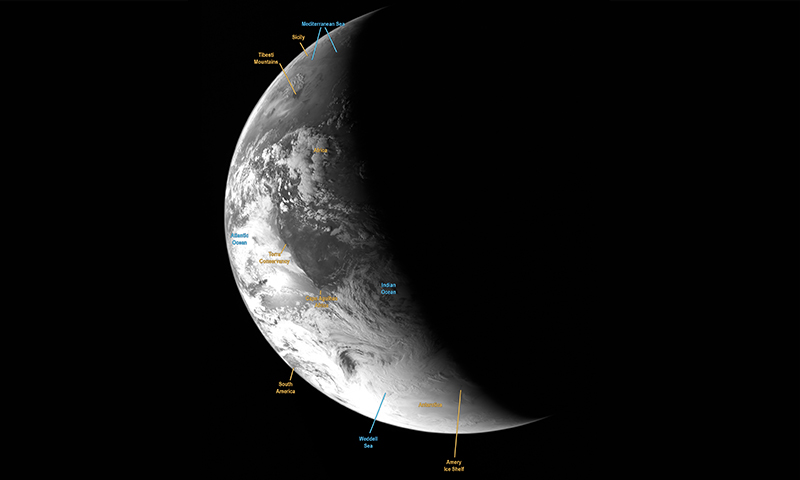A recent photo taken by the Lunar Reconnaissance Orbiter (LRO) has revealed a very unusual subject – Earth!
Typically, as its name suggests, the LRO is pointed at the surface of the moon. But while U.S. Navy Lt. Cmdr. Timothy Musmanno was a student in Space Systems Engineering at the Naval Postgraduate School (NPS), he had the idea to point the LRO at Earth while testing out a new kind of satellite maneuver.
“We asked NASA, and they said, ‘Yes.’ So, Musmanno designed a maneuver that allowed the spacecraft to be quickly repointed to scan Earth’s surface,” said Dr. Mark Karpenko, Research Professor of Mechanical and Aerospace Engineering at NPS, about the work by Musmanno, who graduated from NPS in December 2023.
Retasking a satellite is by no means a small ask. It costs electrical energy which drains batteries or critical propellant which cannot be replenished, and it takes valuable time away from other missions that were already scheduled.
What allowed this opportunity to happen was NPS’ work on fast attitude maneuvering, which is a process that optimizes the movement of a spacecraft as it maneuvers to reorient itself to point in a new direction.
Originally tested on NASA’s Transition Region and Coronal Explorer (TRACE) solar observatory, fast attitude maneuvering allows LRO to perform many observations that would not be possible using its heritage control system. In addition, fast attitude maneuvering has been used to support momentum management operations, similar to the International Space Station’s zero-propellant maneuver, enabling LRO to save enough thruster fuel that its operational life has been extended for three years.
For a spacecraft, getting from Point A to Point B isn’t always a straight line. In fact, usually it’s not. Spacecraft are far from symmetrical objects along all three axes of rotation. Spacecraft parts stick out in different directions and have different shapes, sizes, and masses. So, their mass properties must be considered, from antennas and solar arrays to sensors and maneuvering systems, and everything in between.
The effects of gravity and solar radiation pressure also add to the equation, as well as any obstacle avoidance that’s necessary, such as preventing delicate sensors from pointing directly at the sun.
In the end, a seemingly circuitous move in three dimensions turns out to be the quickest and most fuel-efficient move of them all.
“We've been able to take ideas from the drawing board and the classroom all the way up to practical and operational implementation on NASA systems. And, obviously, there's all kinds of other applications and implications for DOD space systems,” noted Karpenko. “And there are many opportunities for NPS students to become involved by working with NPS’ recently launched CubeSat Mola, and soon to be launched CubeSat Otter.”
• More about Space Systems at NPS: https://nps.edu/web/ssag
• See how NPS tested fast attitude maneuvering on NASA’s TRACE satellite: https://nps.edu/-/nps-teams-up-with-nasa-industry-to-test-groundbreaking-maneuvers-on-spacecraft-in-orbit


